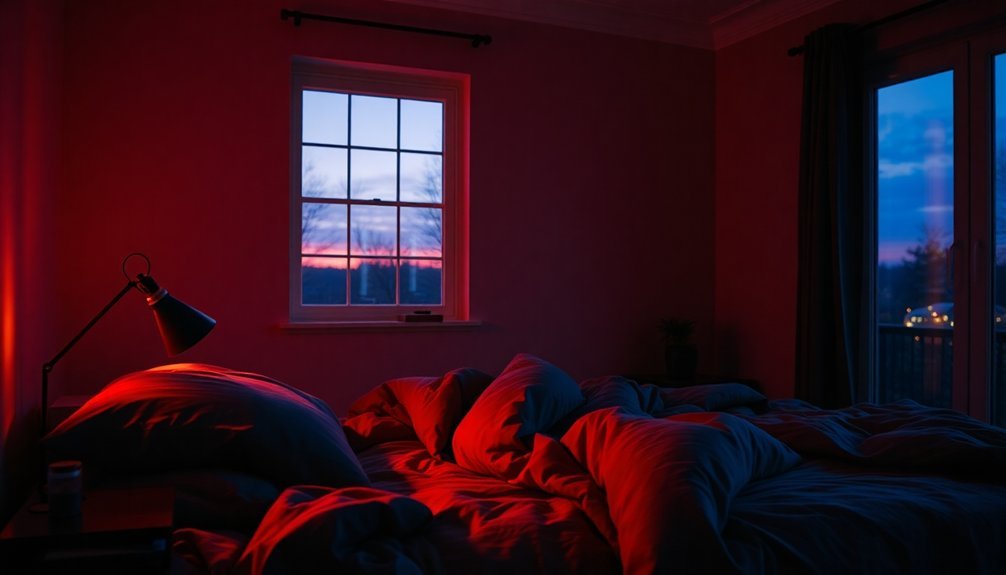To boost your melatonin levels, stick with long wavelengths like amber (595 nm) and red (660 nm) light. These wavelengths have minimal impact on melatonin, helping you maintain a healthy sleep cycle. Avoid short wavelengths, especially blue light (around 470 nm), as they can greatly suppress melatonin production and disrupt your sleep. For the best results, consider integrating red light therapy into your routine, as it enhances sleep quality without hindering melatonin levels. Managing your light exposure can make a big difference, and there's more to explore on how to optimize your sleep environment.
Impact of Light Wavelengths

The influence of light wavelengths on melatonin levels is a fundamental aspect of understanding our circadian rhythms. Long wavelengths, like amber (595 nm) and red (660 nm), have minimal impact on melatonin onset and don't greatly phase advance or suppress melatonin production.
Basically, your body's circadian system is less sensitive to these longer wavelengths, meaning they won't disrupt your melatonin levels much.
On the other hand, medium wavelengths, such as green (525 nm) and blue-green (497 nm), can have a more pronounced effect. They can delay your dim light melatonin onset (DLMO) by 27 to 36 minutes but still fall short compared to the effects of shorter wavelengths. Moreover, exposure to bright AEE light has been shown to delay melatonin production, supporting the idea that timing matters in relation to light exposure.
While exposure to medium wavelengths can suppress melatonin, it's not as drastic as what you'd experience with blue light.
Timing matters too. Light exposure from the afternoon to early evening can delay melatonin production, impacting your overall circadian rhythm.
If you expose yourself to bright light before bedtime—even at low levels—you risk considerable melatonin suppression.
Recognizing the role of these wavelengths can help you craft an evening routine that supports melatonin levels and promotes better sleep.
Short-Wavelength Light Effects
When you're exposed to short-wavelength light in the evening, it can greatly suppress your melatonin production. This disruption not only delays your melatonin onset but can also disturb your overall sleep quality. Understanding these effects will help you manage light exposure for better sleep and a healthier circadian rhythm. Moreover, this suppression can lead to increased alertness and cognitive performance, especially in the context of short wavelength light exposure.
Melatonin Suppression Mechanism
Short-wavelength light, particularly in the blue spectrum, plays an essential role in melatonin suppression. When you expose yourself to light around 470 nm, you can experience a drastic reduction in melatonin production, which is vital for regulating your sleep-wake cycle. Melatonin levels can drop by 65% to 81% under these shorter wavelengths, inhibiting your body's natural sleep signals. Blue light is known to suppress melatonin more powerfully than any other color of light.
Here's a quick breakdown of the wavelengths and their effects:
| Wavelength | Melatonin Suppression Level |
|---|---|
| 470 nm (blue) | High Suppression (65%-81%) |
| 497 nm (blue/green) | High Suppression (65%-81%) |
| 525 nm (green) | Significant Suppression |
| 595 nm (amber) | Minimal Suppression |
| 660 nm (red) | Lowest Suppression |
These photoreceptors, sensitive particularly around 460 nm, influence your alertness and circadian rhythms. Exposure to short-wavelength light can delay your melatonin release and disturb your sleep cycle. The effects are more pronounced with blue light than with green, making it vital to manage light exposure, especially during the evening.
Evening Light Detriments
Exposure to bright light in the evening can have significant detrimental effects on your melatonin production and overall sleep quality. Short-wavelength light, particularly between 470-525 nm, dramatically suppresses nocturnal melatonin levels. If you're exposed to bright light without filtering these wavelengths, you'll likely experience a substantial reduction in melatonin.
In fact, studies show that using goggles that filter out wavelengths under 530 nm helps maintain melatonin levels similar to those in dim light.
This short-wavelength light is intricately tied to sleep disturbances. Increased exposure correlates with a higher prevalence of issues during the night. When short-wavelength light dominates your environment, you may find yourself more susceptible to sleep disturbances and lower melatonin levels.
The sensory pathways in your eyes are particularly responsive to these shorter wavelengths, which can disrupt your circadian rhythm.
To mitigate these effects, minimizing exposure to short-wavelength light in the evening is essential. Consider using amber or red light sources or employing filters to reduce short-wavelength emissions.
Adopting these strategies can preserve your melatonin production and improve your overall sleep quality.
Long-Wavelength Light Effects

Although long-wavelength light, such as red or amber tones, plays a minimal role in suppressing nocturnal melatonin levels, understanding its effects remains essential. These longer wavelengths, around 595 nm to 660 nm, don't greatly affect melatonin secretion or phase advance your body's melatonin rhythm.
Unlike short-wavelength light, which can noticeably suppress melatonin and shift circadian rhythms, long-wavelength light's impact is quite limited. Importantly, the intensity and duration of long-wavelength light exposure won't change its minimal effects on melatonin. Even at higher intensities, these wavelengths aren't effective at suppressing melatonin like shorter wavelengths, which range from 470 nm to 525 nm.
In fact, the duration of exposure leads to no notable change in melatonin suppression from long-wavelength light. For practical applications, you can rest assured that long-wavelength light won't interfere much with your melatonin levels.
Blocking blue or green light, known for their potent suppression of melatonin, is much more beneficial. In settings where melatonin conservation isn't critical, such as daytime environments, using long-wavelength light can be perfectly fine without concern for disrupting your natural sleep cycles.
Red Light Therapy Benefits
Red light therapy offers a range of impressive benefits that can enhance your overall well-being. This therapy stimulates collagen production, keeping your skin firm and elastic. You'll notice a reduction in fine lines, skin pigmentation, and an overall youthful complexion. It also aids in healing acne and reducing scars, improving your skin texture and minimizing signs of aging.
Beyond skincare, red light therapy provides significant pain relief. If you suffer from chronic pain, like arthritis, you'll appreciate how it lowers inflammation and enhances blood flow. After workouts, it helps your muscles recover by reducing soreness and increasing circulation, delivering essential oxygen and nutrients to tissues.
Additionally, it supports mental health and improves sleep quality. By boosting serotonin production, it may help lessen symptoms of depression and anxiety. You'll experience better sleep as it enhances melatonin secretion, promoting a more regulated sleep-wake cycle.
With reduced feelings of tension and stress, red light therapy can transform your nighttime rest without inhibiting melatonin production like blue light does. To sum up, this therapy can lead to better skin, less pain, and improved sleep, positively impacting your overall health.
Natural Light Exposure Importance

Getting enough natural sunlight is essential for your overall well-being and melatonin production.
When you soak up those morning rays, you help regulate your circadian rhythm and signal your body to prepare for rest later in the day.
Skipping out on evening light is equally important, as it allows your body to produce melatonin when darkness falls.
Benefits of Sunlight Exposure
Embracing sunlight exposure offers numerous benefits that can greatly enhance your overall well-being. Spending time in the sun not only boosts melatonin production but also elevates your mood and strengthens your immune system. Here's a quick overview of what sunlight does for you:
| Benefits | Effects |
|---|---|
| Melatonin Production | Facilitates easier sleep at night |
| Mood Enhancement | Increases serotonin and beta-endorphins |
| Immune System Boost | Activates CD8 cells for better defense |
| Heart Health | Improves blood flow and lowers blood pressure |
| Mental Health | Reduces rates of suicide and promotes relaxation |
Getting enough sunlight, especially in the morning, helps reset your internal clock and optimize melatonin regulation. Additionally, it boosts your immune response and aids in physiological functions like nitric oxide production, which is beneficial for your heart. With these advantages, it's clear that sunlight is a crucial component of a healthy lifestyle. So, next time the sun shines, step outside and soak it in—you'll be doing your body and mind a favor!
Evening Light Absence
Exposure to evening light can considerably impact your melatonin levels and sleep quality. Any light exposure in the evening suppresses melatonin production, with even dim light capable of reducing levels by up to 99%.
Short-wavelength light, especially blue light, has a particularly strong effect, keeping melatonin levels suppressed for up to 50 minutes after the light's turned off. This disruption can lead to later bedtimes and less sleep overall, as your body struggles to align its circadian rhythm with the day-night cycle.
For sensitive populations, like children and older adults, the effects of evening light can be even more pronounced. Preschoolers, for instance, can experience significant melatonin suppression from low-intensity light, making it essential to manage their exposure.
To enhance your sleep quality, consider strategies like turning off screens at least an hour before bed and using night mode on devices. Switching to red or yellow light bulbs for evening use can also help.
Natural Melatonin Production
Natural light plays an essential role in regulating your body's internal clock and boosting melatonin production. When you expose yourself to morning light, it synchronizes your circadian rhythm with the 24-hour day, leading to more effective melatonin release at night.
Sunlight also helps produce serotonin, a neurotransmitter vital for melatonin synthesis. Higher serotonin levels during the day mean more melatonin at night, enhancing your overall sleep quality.
If you spend time indoors without natural light, you risk disrupting your circadian rhythm and delaying melatonin production. This disruption can lead to sleep irregularities and negatively impact your mood, alertness, and metabolic functions.
On the flip side, getting ample natural light, especially in the morning, helps you fall asleep earlier and fosters a more consistent sleep-wake cycle.
Morning light stimulates specialized cells in your retinas that halt melatonin production temporarily, allowing you to wake up feeling refreshed.
Additionally, research shows that individuals exposed to bright morning light exhibit improved cognitive function and decision-making skills.
Artificial Light and Melatonin
Artificial light greatly disrupts your body's production of melatonin, especially during the night. Even low levels of light can interfere, with just 6 lux being sufficient to impact your melatonin levels. The type of light matters too; shorter wavelengths like blue and green light suppress melatonin more effectively than red or amber light. This disruption can adversely affect your sleep-wake cycle and lead to various health issues.
| Wavelength Color | Suppression Effect | Circadian Shift Duration |
|---|---|---|
| Blue | High | 3 hours |
| Green | Moderate | 1.5 hours |
| Red | Minimal | No significant effect |
Inadequate melatonin production due to artificial light exposure is linked to weight gain, mood disorders, and even certain health risks. Light pollution from urban environments can exacerbate these issues. To mitigate the effects, reducing exposure to artificial light in the evening and using blue-light-blocking glasses can help you maintain natural melatonin production and support your circadian rhythms. Adjusting your environment is essential for better sleep and overall health.
Optimizing Light for Sleep

Optimizing your sleep environment can greatly enhance melatonin production and improve overall sleep quality. To achieve this, focus on the wavelengths of light you expose yourself to, especially in the evening.
Red light, particularly at 660 nm, is your best ally for boosting melatonin. It penetrates the skin, promotes blood flow, and enhances melatonin levels without disrupting your circadian rhythms. Studies show that even 30 minutes of full-body red light therapy can elevate melatonin levels considerably.
Conversely, avoid shorter wavelengths between 470-525 nm, like blue and green light, as they can suppress melatonin production and disrupt your sleep cycle. These lights trigger alertness, making them unsuitable for evening use.
Instead, consider incorporating human-centric LEDs designed to emit wavelengths that align with natural circadian rhythms. These advanced lights can dynamically adjust to enhance melatonin at night while minimizing it during the day.
Implementing a consistent light therapy plan, tailored to your needs, can make a remarkable difference. By consciously optimizing your light exposure, you pave the way for deeper, more restorative sleep and enhanced melatonin levels.
Frequently Asked Questions
Can Supplements Help Increase Melatonin Levels Naturally?
Yes, supplements can help you increase melatonin levels naturally. They're particularly effective for improving sleep quality, but it's essential to monitor your dosage to avoid side effects like daytime drowsiness or disturbances in your circadian rhythm.
How Does Diet Affect Melatonin Production in the Body?
Your diet plays an essential role in melatonin production. Consuming foods high in melatonin and tryptophan, like oats and cherries, while limiting caffeine and alcohol can enhance your body's ability to produce this important hormone.
What Role Does Exercise Play in Melatonin Regulation?
Exercise plays an essential role in regulating your melatonin levels. High-intensity workouts boost melatonin production, especially when done later in the day. Regular, longer exercise durations can enhance sleep quality and synchronize your circadian rhythm.
Are There Any Health Risks Associated With Melatonin Supplements?
Yes, there are health risks with melatonin supplements. You might experience daytime sleepiness, headaches, nausea, or dizziness. Special groups, like pregnant individuals and children, should consult doctors before use to avoid potential complications.
How Does Aging Impact Melatonin Secretion and Sleep Quality?
As you age, melatonin secretion decreases, impacting your sleep quality. Reduced levels can lead to sleep disturbances and disorganized circadian rhythms, making it harder for you to achieve restful sleep and stay energized throughout the day.
In Summary
In conclusion, the right wavelengths of light can greatly influence your melatonin levels and, consequently, your sleep quality. Short-wavelength light can disrupt melatonin production, while longer wavelengths, like red light, can enhance it. Prioritize natural light exposure during the day and limit artificial light at night to optimize your sleep environment. By understanding and managing your light exposure, you can take proactive steps towards better sleep and improved overall health.





Leave a Reply